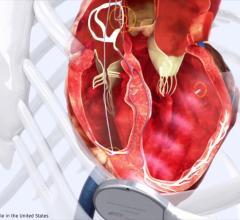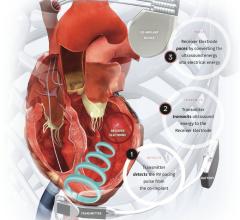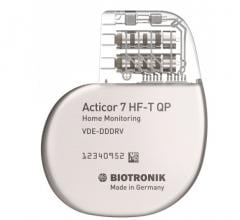
Integrating data from an array of implantable EP devices from different vendors can be difficult or require disconnected silos of data for different vendors. One solution that was recently introduced to integrate data from various vendors is the Optimize EP software, which allows viewing data from all device vendors in one platform to streamline workflows.
A few weeks ago, a patient of mine experienced a cardiac event — his heart stopped. Completely. However, his implantable cardioverter defibrillator (ICD) did exactly what it was designed to do — it shocked him and it saved his life. There was just one problem, my patient had no idea that his heart had stopped or that he had been shocked because he was asleep.
Luckily, his device was being monitored remotely. An actionable alert was sent to us, and we were able to call him the next morning to schedule an appointment. As it turns out, he was having mild heart attack symptoms and needed a stent, which he was able to get in a matter of days. None of this would have been possible without remote monitoring. But while many of the advantages of the technology are clear, it is only one side of a story that is fast increasing in complexity.
EP Remote monitoring is Now Common and Reduces Response Time
Remote monitoring technology is becoming commonplace in cardiac electrophysiology. Over the last decade, we have seen a steady rise in adoption of remote monitoring technologies for cardiac devices, due in large part to the publication of a couple of groundbreaking clinical studies, including the TRUST trial in 2010, which demonstrated that remote monitoring could reduce the average time between the onset of an arrhythmia and a physician evaluation by almost 90%, from 40 days down to just 5.5 days.[1]
Reducing response times to these actionable events is ultimately what saves lives, including my patient’s, and while compliance rates are not yet perfect, they are improving, and more actionable events are being addressed in a timely manner as the technology becomes more sophisticated. Remote monitoring has undoubtedly created never-before-seen advantages for cardiac device patients. Its rapidly growing prevalence, a byproduct accelerated by both technological innovations and the COVID-19 pandemic, has also illuminated some of its shortcomings.
With current remote monitoring practices, patients come into the office every 90 days to have their devices checked (about four times per year), provided there have not been any device interrogations that have been deemed actionable and required immediate attention. Even then, the process to obtain the cardiac data that is being transmitted involves the following:
• Contacting the specific device company representative in the event of an emergent actionable event or consulting the alert directly as it is streamed to the device’s remote monitor
• Downloading the cardiac data from the device company’s secure server
• Printing the data
• Reading the data
• Signing off on the data
• Initiating any follow-up appointments or actions based on the data
• Scanning the data into EMR
• Billing for the time spent with the data
It is a cumbersome and time-consuming process, and each cardiac device manufacturer must be consulted separately. Our practice includes nearly 4,000 patients. This equates to roughly 16,000 total office visits each year, and each office visit involves 6-10 pages of patient device data plus all of the previous steps listed above. My fellow physicians and I were spending four to five hours per week reading through and signing off on our patients’ remote monitoring data. And our care teams were spending just as much time printing, scanning and billing.
And by 2018, the cardiac device patients at our practice were nearly 100% remote monitored. However, the amount of work required to obtain the cardiac data, to examine the data, to keep accurate record of the data and to accurately account for the time spent with the data for precise reimbursements was putting a massive strain on our practice operationally and financially.
Something had to change.
Integrating Remote Monitoring From Various EP Vendors Into One Interface
We sought out companies designing software that could integrate remote monitoring technology from the four largest cardiac device manufacturers — Abbott, Medtronic, Boston Scientific, and Biotronik — into one automated, customizable and completely digitized user interface. This would effectively streamline and simplify the tedious data management processes that are currently standard practice. Unfortunately, it quickly became apparent that while much of the software being developed included elements of what we needed, none of them included exactly what we were envisioning.
A question arose: What if we designed our own software that could address the most pressing issues EPs and their care teams were facing in managing remote monitoring data? So, that is what we did.
We created the company Optimize EP and our proprietary software, CaRM (pronounced See-Arm), came into existence, but before we could begin the process of potentially helping other EPs enhance the management of their own remote monitoring data, we had to make sure we were addressing definitive needs in a way that would increase efficiency across all aspects of the remote monitoring landscape.
We worked out deals with the four primary cardiac device companies, as well as iRhythm, which deals in external monitors, to facilitate access to the data being transmitted by their respective devices so that our software could house cardiac data from all five companies on a single user interface and online platform.
Automated, Digitized and Customizable Processes and Billing Integration in Remote EP Device Monitoring
We designed the infrastructure of the software so that all device interrogations were automated, instantaneous and entirely digital. There was no more printing thousands of pages each week.
We also made the user interface customizable so that specific alerts could be tailored to specific device patients. Now, barring any actionable alerts or interrogations, our patients only come into the office once per year. Remote monitoring in combination with CaRM takes care of the rest.
Automated EMR and billing integration were also the keys to streamlining remote EP monitoring operations. We are now able to upload any patient’s cardiac device data and chart notes automatically from a mobile device and into EMR while simultaneously having that time billed accurately and with the proper codes.
Over the last year, we have reduced our workload in this area by 90% and increased our reimbursement efficiency by 47%. This has created more chances for us to spend more significant, meaningful time with even more patients, while keeping our practice sustainable and efficient.
Launching Optimize EP and CaRM at the beginning of 2021 has presented a number of unique opportunities to explore, both for us and for the EPs and hospitals that it can benefit, but more importantly, the years-long process in bringing everything full circle is a compelling reminder that physicians can be powerful agents for change in healthcare when there is a gap to be filled, and that we should embrace that role as often as we can, even if it means filling the gap ourselves.
Remote monitoring is a young, agile, and rapidly evolving technology that has been proven to save lives and help patients live longer, and because the pandemic has altered the way we practice medicine, probably for good, we are only just beginning to discover what’s possible in terms of improving patient outcomes and considering how impactful the improvement of remote monitoring technology can be.
About the author: Maninder Bedi, M.D., is the founder and chief medical officer of Optimize EP. He also is a board-certified electrophysiologist at Wheeling Hospital in Wheeling, W.Va.
Related EP Remote Monitoring Content:
VIDEO: Rising Interest in Remote Monitoring of EP Devices in the COVID-19 Era — Interview with Robert Kowal, M.D.
EP Trials Show Positive Results for Advanced Remote Monitoring and Micra Transcatheter Pacing
Medtronic Receives FDA Approval for CareLink SmartSync Device Manager
Find more EP Lab news and video
Reference:


 April 25, 2025
April 25, 2025 








